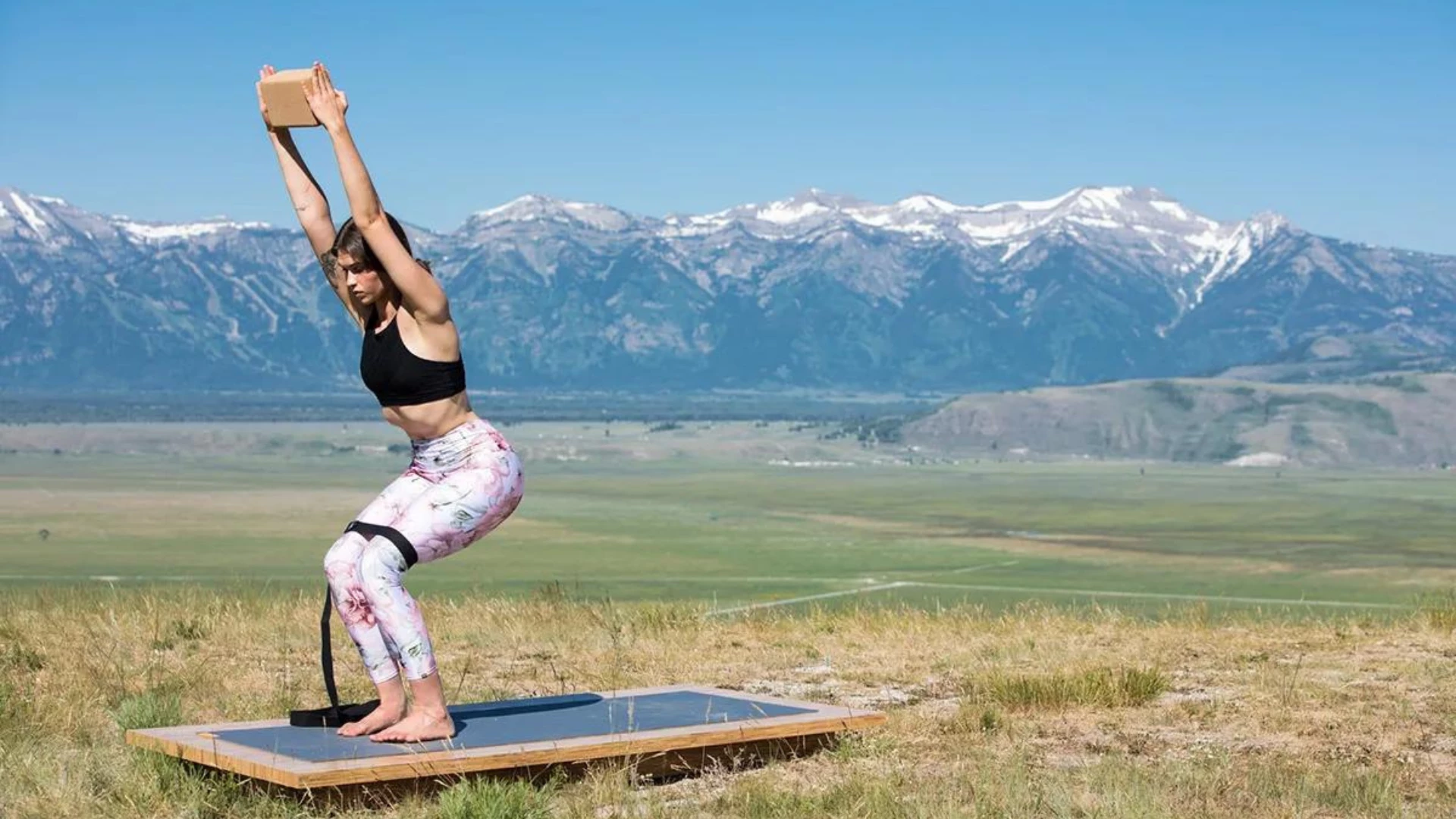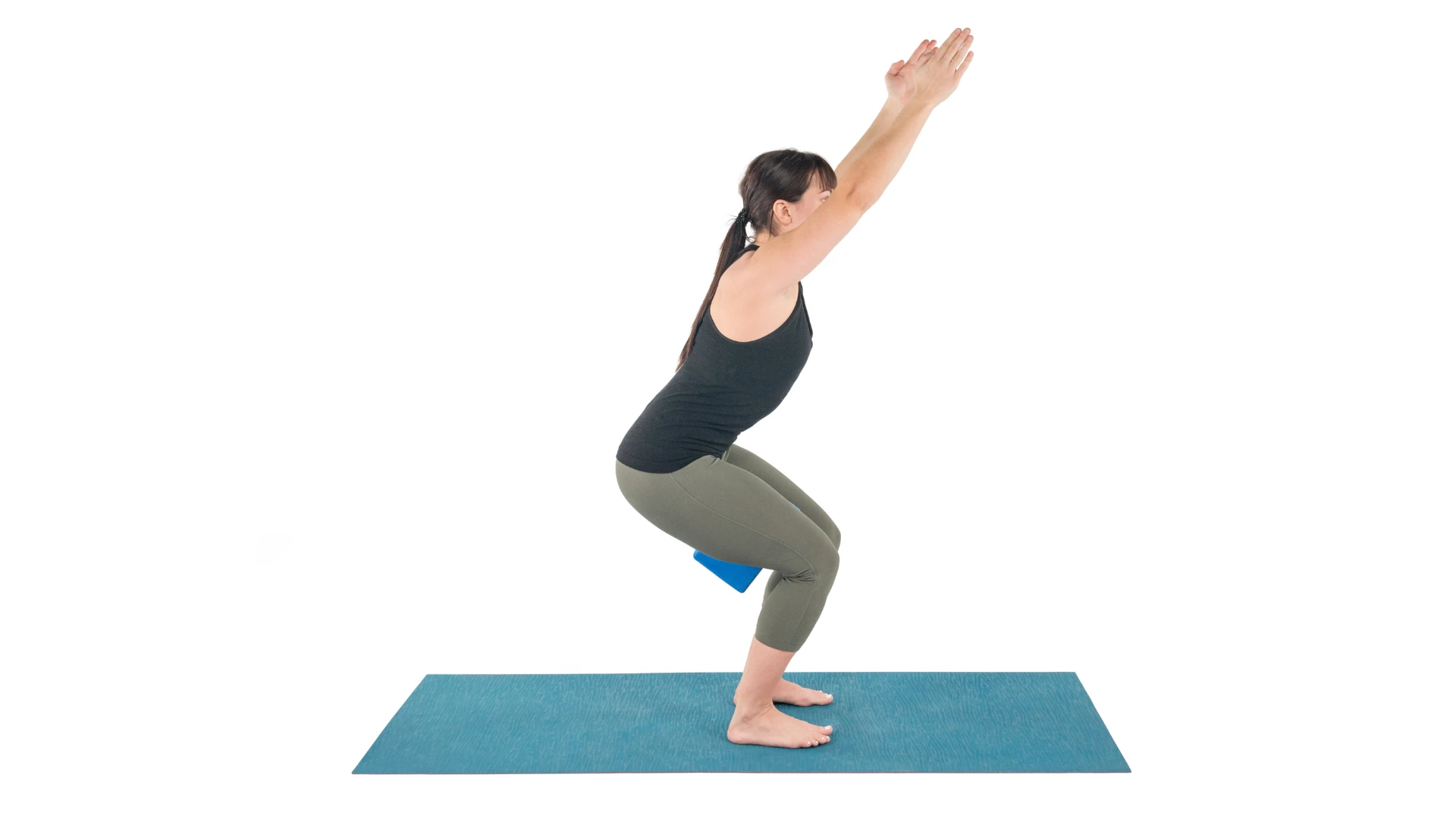Utkatasana: Use Yoga Props to Stabilize and Energize Fierce Pose

Article At A Glance
Utkatasana is a powerful, heat-building pose that engages pretty much the entire body. Practicing Fierce Pose strengthens the feet, ankles, legs, hips, core muscles (abs and back muscles), and shoulders. Using a yoga block and strap can further strengthen your pose by teaching your body to recruit all the muscles needed for a strong, stable pose.
Flexible people tend to self-select for yoga. Of course, anyone with any body type can benefit from yoga practice. But those of us who were born with flexible bodies gravitate to the practice because asanas that highlight hypermobility—which make up the bulk of modern yoga poses—are easy for us. It wasn’t until I began to realize that hypermobility is not a state of balance (inspired by bilateral hip replacements) that I began to appreciate strengthening poses more. Since then, Fierce Pose (Utkatasana) has become a regular part of my practice.
Utkatasana is a powerful, heat-building pose that engages pretty much the entire body. Practicing Fierce Pose strengthens the feet, ankles, legs, hips, core muscles (abs and back muscles), and shoulders. In my experience, it seems to ground and focus my mind and to collect my body into a cohesive whole.
UTKATASANA FOR FLEXIBLE PEOPLE
I didn’t always love Utkatasana. Because it’s a strengthening pose, it always felt challenging. It didn’t have that effortless quality I loved in the poses that exploited my natural flexibility. But I’ve come to appreciate the stabilizing effects of the pose. And I can maximize the strengthening benefits by adding a yoga strap and a yoga block to my practice.
Hypermobile people tend not to recruit all the muscles or the correct muscles when challenging their strength. Consequently, some muscles become underdeveloped, and the ones that are taking up the slack can become overdeveloped. When we practice yoga, we often repeat our body’s familiar patterns in our poses. Using a yoga strap around our legs and a yoga block between our hands in Utkatasana helps us engage all the muscles necessary to find stability and ease in the pose.

CONTRAINDICATIONS FOR FIERCE POSE
Like all yoga poses, Utkatasana comes with cautions. People who are experiencing the following should avoid practicing the pose:
- Uncontrolled high or low blood pressure
- Headache
- Recent foot, ankle, or knee problems
- Low back injury
Of course, many of these conditions are temporary, so you may need only avoid the pose for short periods. As always, pay attention to your body, not only while you’re practicing the pose but also the next day. If your condition worsens immediately or a day after practicing the pose, that’s a clear signal to set it aside until your condition is healed.
HOW TO PRACTICE UTKATASANA WITH A STRAP AND A BLOCK
- Gather props: a yoga mat, block, and strap. Any yoga block will work, but remember that the wood and cork blocks are much heavier than the foam blocks. Wood and cork blocks will demand more from your arms and shoulders for maximum arm strengthening. If you’re concerned about the possibility of dropping the block on your head, you might want to stick with foam.
- Make a loop in your strap, and then place the loop around your thighs, just above your knees. Tighten or loosen the strap so that it keeps your legs hip-width apart. Press your thighs into your strap to keep the strap from falling down.
- Standing in Mountain Pose (Tadasana) on your yoga mat, hold your block widthwise between your hands. Your arms can be extended downward in front of you.
- Now, tilt your pelvis forward, sending your tailbone back so that your knees bend. Allow your torso to bend forward from the hip joints.
- Press your thighs into the strap. Do you feel more areas of your hips and legs engaging to support your pose?
- Pressing your hands into your block, raise your arms up toward the sky. As you press inward, notice what areas of the arms and shoulders are working.
- Stay in the pose for 3 to 5 deep, relaxed breaths or longer if you like.
- Return to Tadasana and relax your arms.
- Repeat the pose if you like.
Also, read...
4 Chair Pose Variations to Improve Strength and Balance
3 Creative Ways to Practice Cobra Pose
Change Your Perspective of Pelvic Tilting: How the Transversus Abdominis Can Help
Related courses
Breath as Medicine: Yogic Breathing for Vital Aging
Yoga and Myofascial Release: Releasing Chronic Tension with the Bodymind Ballwork Method
Yoga and Detoxification: Tips for Stimulating Lymphatic Health

Charlotte Bell began practicing yoga in 1982 and began teaching in 1986. She was certified by B.K.S. Iyengar in 1989 following a trip to Pune. In 1986, she began practicing Insight Meditation with her mentors Pujari and Abhilasha Keays. Her asana classes blend mindfulness with physical movement. Charlotte writes a column for Catalyst Magazine and serves as editor for Yoga U Online. She is the author of two books: Mindful Yoga, Mindful Life, and Yoga for Meditators, both published by Rodmell Press. She also edits Hugger Mugger Yoga Products’ blog and is a founding board member for GreenTREE Yoga, a non-profit that brings yoga to underserved populations. A lifelong musician, she plays oboe and English horn in the Salt Lake Symphony and the folk sextet Red Rock Rondo whose 2010 PBS music special won two Emmys.





